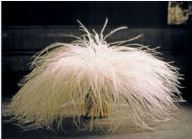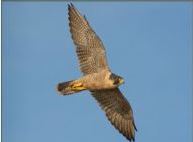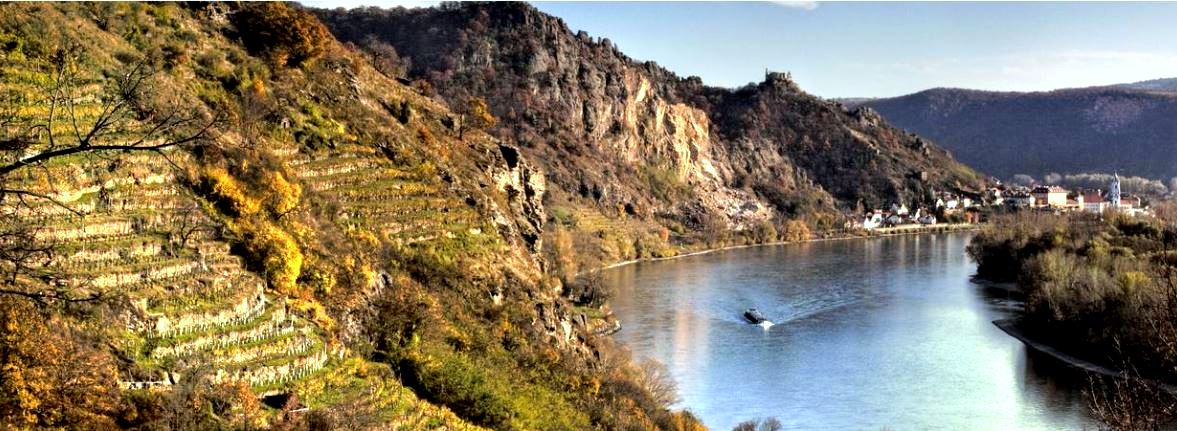By Brigitte Hasbron of The Food Tease
Known for its picturesque natural and cultural landscapes around the world, the Wachau Valley is a region where wine enthusiasts and aficionados want to immerse themselves in all things liquid and gold. A wine lover’s place to be.
Being a food blogger and seeing how food and wine are synonymous with the perfect marriage, it was fitting that I was invited to two well-known vintners in Lower Austria, specifically in the famous Wachau Valley.
The sites of the Danube River and the enchanting towns that we drove through to reach our first vineyard were postcard worthy… even on a somewhat cloudy day.
It was only when we stopped to take pictures, that I took full notice of the meticulously maintained vineyards which are famous for their hand-laid stone terraces. Extraordinary!
The Wachau Valley
When one reads “renowned winegrowers and internationally acclaimed wines, promising sheer pleasure”, you know that you are in good hands and that you are about to embark on a palatable and tasty journey.
My intoxicating wine-filled journey started off by understanding the rich wine history of the Wachau Valley, and why it is this particular region that births such award-wining wines.
Two factors that are responsible for exceptional winemaking in the Danube:
Special climate: the interface between the moist air of the Atlantic and the dry Pannonian air (low precipitation, hot summers but only moderately cold winters) as well as the rich and varied soils over a relatively small geographical area, which include primary rocks, loess (equal parts of sand and silt), clay and sandy gravel soils. My geography teacher would be so pleased that I actually understand this.
Well-trained and committed winegrowers: some of whom have reached international standing. Winegrowing has a long tradition in the Danube area. Even the Romans engaged in winegrowing here. According to my research, the Romans laid the foundations for the characteristic wine terraces and winegrowing culture which is still prevalent in the Danube region of Lower Austria today.
Formula for their success: “The combination of innovation, excellent understanding of the quality and knowledge of the climate and terroir”.
Grape Experience
Visitors like myself have the opportunity to sample top quality wines in the internationally renowned Wachau winegrowing area on the Danube. The area in which I visited is known for their chardonnays and yellow muscatels; however, it is the Wachau Rieslings and its Grüner Veltliner that has put Austria on the international scene, thus making the Wachau Valley Austria’s best-known winegrowing area.
The Vinea Wachau
The Vinea Wachau, is an association of Wachau winegrowers who produce wines and classifies them into three distinct classifications: Steinfeder, Federspiel, and Smaragd. Each classification signifies the style of wine (light bodied, full bodied, etc.).
The classification can be found on the label of the wine bottle; and, you should also see it as part of the name of the wine when reading it on a restaurant wine list or in a retail catalogue (e.g. Grüner Veltliner Federspiel Terrassen 2015).
This informs the wine lover of two things: that the wine is from the Wachau region and the style of the wine.
The Grape Ambassadors of Austrian White Wine
Steinfeder, Federspiel, and Smaragd wines are considered ambassadors of the Austrian white wine culture and especially of the World Cultural Heritage Wachau.
Admittedly, I needed to know as much as I could about Austrian wines and what makes them stand out amongst the rest of the world. So believe me when I say, there were plenty of questions as I took one sip after another in their liquid gold.
I quickly learned that the three classifications are completely unique to Austria and that a similar example of them cannot be found in all of Europe. I was also educated that the “designations serve as an orientation structure for wine lovers, because it allows for dry white wines to be defined according to three weight classes, each of which is based on natural alcohol content.”
Tasting & Origin Notes

![]() Fruity charm and a stipulated maximum alcohol content of 11.5% by volume characterize the lightest style of top Vinea Wachau wines – the Steinfeder.
Fruity charm and a stipulated maximum alcohol content of 11.5% by volume characterize the lightest style of top Vinea Wachau wines – the Steinfeder.
The name itself refers to the typical “Steinfedergras” (Stipa pennata), a grass which grows near the vines in the Wachau’s terraced vineyards; it is light like a feather, and fragrant – just like the wine named after it.

 This classic dry wine is distinguished by a strong, nuance-rich character. Federspiel wines feature an alcohol content of between 11.5% and 12.5% by volume. The name Federspiel refers back to the times of falconry, when this favourite form of noble hunting was practiced in the Wachau.
This classic dry wine is distinguished by a strong, nuance-rich character. Federspiel wines feature an alcohol content of between 11.5% and 12.5% by volume. The name Federspiel refers back to the times of falconry, when this favourite form of noble hunting was practiced in the Wachau.
![]()
 Smaragd is the name for the best, most treasured wines from the Vinea Wachau members. The alcohol content of these wines begin at 12.5% by volume. This, along with the highest grape ripeness and natural concentration are what make this world-class designation possible.
Smaragd is the name for the best, most treasured wines from the Vinea Wachau members. The alcohol content of these wines begin at 12.5% by volume. This, along with the highest grape ripeness and natural concentration are what make this world-class designation possible.
Emerald coloured lizards – also known as Smaragd – are at home in the terraced vineyards of the Wachau. On bright, sunny days, their beauty is highlighted dramatically as they bask in the gleaming sun next to the grapevines – the perfect symbol for the absolute top Wachau wines with full physiological ripeness.
“The Wachau is characterized by terraced vineyards, often towering steeply one on top of the other, in which world-class Gruner Veltliner and Riesling grapes grow amid weather-worn ancient rock.” – Wachau Travel Guide
Wineries
Domäne Wachau Winery

With over 400 hectares, Domäne Wachau has positioned its wines in over 40 different countries and is among the most well-known Austrian wineries in the world and has ascended to ‘Austria’s white-wine elite’.
With their harvest consisting of 95% white wine and 5% red wine, it is safe to say that Domäne Wachau focuses predominantly on Austrian Grüner Veltliner (75%) and on Riesling (20%) wines. The remaining percentages concentrate on Pinot Blanc, Chardonnay and Muscat.

My visit to Domäne Wachau was not only one of education, but an appreciation of the labour intensive craftsmanship that is involved in constructing and maintaining these hand-laid stone terraces that the vines grow on.
“Domäne Wachau is one of the few wine co-operatives in the world to belong to the top vintners for its quality.” – Domäne Wachau
Walking amongst the vineyards, one can hike up to the beautiful lookout that also doubles as the perfect picnic area.
Picture it: enjoying some bread and cheese with a glass of wine as you take in the sights of the winery with the famous Danube River as the backdrop. Now that is a view to behold!

Nearly two thirds of the vineyards are very steep and terraced with ancient dry stonewalls earning the region the status of an UNESCO World Cultural Heritage site.
And if the winery wasn’t enough to impress, special occasions can be enjoyed at the beautiful “Kellerschlossel“- the Baroque Cellar Palace which can be reserved for weddings and celebratory milestones alike.
“The small baroque chateau is nestled in the Wachau vineyard slopes and its picturesque setting lures visitors and hikers to pause for leisure.”

No tour would be complete without visiting Domäne Wachau’s 300 year old Baroque wine cellar.
Going down 15 metres into the mouth of the cellar, I am informed of the intricate workings involved in the wine process: the juice handling, the reductive fermentation and the juice clarification.
Learning seems easy when you are surrounded by beautifully etched oak barrels depicting wine history to the sleek and sexy stainless steel casts holding young wine.
 During my wine tasting, the staff were not only eager to answer all of my questions, but also encouraged me to ask more as they take great pride in their products, and for good reason.
During my wine tasting, the staff were not only eager to answer all of my questions, but also encouraged me to ask more as they take great pride in their products, and for good reason.
Nearly all the wines can be tasted and purchased on the premises at their wine store (open from April to October). Guests are encouraged to try a variety of wines and take in the ‘Wachau’ moment which is an unforgettable experience.
A wine lover’s paradise to say the least.
Holzapfel Prandtauerhof Winery & Restaurant
Now that I had a thorough knowledge of the Wachau region and its wines, I had the pleasure of having lunch at the Holzapfels winery and restaurant.

With its rustic furnishings and beautifully designed courtyard, the cozy manor restaurant sits on its 14 hectar estate, all of which was idyllic for an afternoon luncheon.
As I walked through the wine tasting area with its stone walls and wood laden décor it gave me the impression of a yester-year feeling. Classic yet unpolished, homey in nature.
I was literally in for a surprise when it came to the food bounty that was about to present itself before me. The owner of the restaurant and her team made the luncheon one that I will literally never forget!

The wines that were presented to accompany each course were spot on as they married perfectly with each savoury dish.
Being not so familiar with all the Austrian signature dishes, especially those from the region, the restaurant staff took the time to explain each one and their significance.

It seemed as though each course outshined the former. Cured meats, homemade spreads, salted pig cheeks, and roast pork and dumplings were just the ‘main events’ during my culinary feast.
It was as though, in one afternoon, I was shown the best of both worlds: wine and food that perfectly painted the Wachau region.
If you are a wine connoisseur and food lover, I would highly recommend experiencing the Wachau Valley, particularly the two wineries that I visited.
One thing that I can guarantee is that you will leave with a new appreciation and admiration for the craftsmanship and manual work that these establishments do for both wine and food.
From someone who has always had a great difficulty in finding wines that easily agreed with her palate, I believe I found the remedy in Wachau’s liquid gold. And with that…Prost!
Brigitte Hasbron
Culinary Travel Writer
Brigitte is the owner of The Food Tease, the Canadian Capital’s only combined culinary and travel blog. She has had the privilege of working as a culinary journalist with some of the best chefs and sommeliers in Canada and abroad.
As an haute cuisine graduate from the most prestigious culinary school in the world, Le Cordon Bleu Institute, Brigitte gained an appreciation of the hard work and sacrifice required to become a successful chef.
Over the years, she has expanded her knowledge of gastronomy and wine by participating, either as a contributor or as a journalist, in various culinary events hosted by world-renowned chefs and master sommeliers.
Brigitte’s passion for food and travel pushes her to promote and give credit to the men and women of the culinary world.
Brigitte’s appetite for all things tasty and her never-ending fascination for learning will always be her driving force. Brigitte strives to inform and educate others regarding all of the splendours that food, wine and travel have to offer. Find her at www.thefoodtease.









